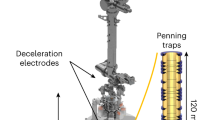Abstract
The precise determination of the 3He/3H mass ratio, and hence the tritium β-decay endpoint energy E 0, is of relevance for the measurement of the electron anti-neutrino mass performed by the Karlsruhe Tritium Neutrino experiment (KATRIN). By determining this ratio to an uncertainty of 1 part in 1011, systematic errors of E 0 can be checked in the data analysis of KATRIN. To reach this precision, a Penning Trap Mass Spectrometer was constructed at the University of Washington and has been transferred to the Max Planck Institute for Nuclear Physics in Heidelberg at the end of 2008. Since then it is called MPIK/UW-PTMS. Special design features are the utilization of an external ion source and a double trap configuration. The external Penning ion source efficiently ionizes the helium and tritium gas and can give superior elimination of unwanted ion species compared to the previously utilized in-trap-ionization by electrons from a field-emission point. The design as a double Penning trap allows a faster measurement procedure. This should help to avoid problems resulting from long-term drifts in the experimental conditions. Additionally, the laboratory in Heidelberg was carefully prepared to have very stable environmental conditions. Experimental challenges and the first Heidelberg results with the new spectrometer are presented.
Similar content being viewed by others
References
Fukuda, Y., et al.: Evidence for oscillation of atmospheric neutrinos. Phys. Rev. Lett. 81, 1562–1567 (1998)
Lesgourgues, J., Pastor, S.: Massive neutrinos and cosmology. Phys. Rep. 429, 307–379 (2006)
Avignone, III, F.T., Elliott, S.R., Engel, J.: Double beta decay, majorana neutrinos, and neutrino mass. Rev. Mod. Phys. 80, 481–516 (2008)
Otten, E.W., Weinheimer, C.: Neutrino mass limit from tritium β-decay. Rep. Prog. Phys. 71, 086201 (2008)
Drexlin, G.: KATRIN-direct measurement of a sub-eV neutrino mass. Nucl. Phys. B Proc. Suppl. 145, 263–267 (2005)
Otten, E.W., Bonn, J., Weinheimer, Ch.: The Q-value of tritium β-decay and the neutrino mass. Int. J. Mass Spectrom. 251, 173–178 (2006)
Blaum, K.: High-accuracy mass spectrometry with stored ions. Phys. Rep. 425, 1–78 (2006)
Van Dyck, R.S. Jr., et al.: Ultraprecise atomic mass measurement of the α particle and 4He. Phys. Rev. Lett. 92, 220802/1 (2004)
Rainville, S., Thompson, J.K., Pritchard, D.E.: An ion balance for ultra-high-precision atomic mass measurements. Science 303, 334–338 (2004)
Nagy, Sz., et al.: On the Q-value of the tritium β-decay. Europhys. Lett. 74, 404–410 (2006)
Van Dyck, R.S., Jr., et al.: The UW-PTMS: systematic studies, measurement progress,and future improvements. Int. J. Mass Spectrom. 251, 231–242 (2006)
Pinegar, D.B.: Tools for a precise tritium to helium-3 mass comparison. PhD thesis, University of Washington, Seattle (2007)
Van Dyck, R.S., Jr., et al.: Ultrastable superconducting magnet system for a Penning trap mass spectrometer. Rev. Sci. Instrum. 70, 1665–1671 (1999)
Van Dyck, R.S. Jr., Zafonte, S.L., Schwinberg, P.B.: Ultra-precise mass measurements using the UW-PTMS. Hyperfine Interact. 132, 163–175 (2001)
Gabrielse, G.: Why is sideband mass spectrometry possible with ions in a Penning trap. Phys. Rev. Lett. 102, 172501 (2009)
Wineland, D.J., Dehmelt, H.G.: Principles of the stored ion calorimeter. J. Appl. Phys. 46, 919–930 (1975)
Farnham, D.L., Van Dyck, R.S. Jr., Schwinberg, P.B.: Determination of the electron’s atomic mass and the proton/electron mass ratio via Penning trap mass spectroscopy. Phys. Rev. Lett. 75, 3598–3601 (1995)
Pinegar, D.B., et al.: Stable voltage source for Penning trap experiments. Rev. Sci. Instrum. 89, 064701 (2009)
Marie-Jeanne, M., et al.: Towards a magnetic field stabilization at ISOLTRAP for high-accuracy mass measurements on exotic nuclides. Nucl. Instrum. Methods Phys. Res. A 587, 464–473(2008)
Brown, L.S., Gabrielse, G.: Geonium theory: physics of a single electron or ion in a Penning trap. Rev. Mod. Phys. 58, 233–311 (1986)
Author information
Authors and Affiliations
Corresponding author
Rights and permissions
About this article
Cite this article
Diehl, C., Blaum, K., Höcker, M. et al. Progress with the MPIK/UW-PTMS in Heidelberg. Hyperfine Interact 199, 291–300 (2011). https://doi.org/10.1007/s10751-011-0324-6
Published:
Issue Date:
DOI: https://doi.org/10.1007/s10751-011-0324-6



